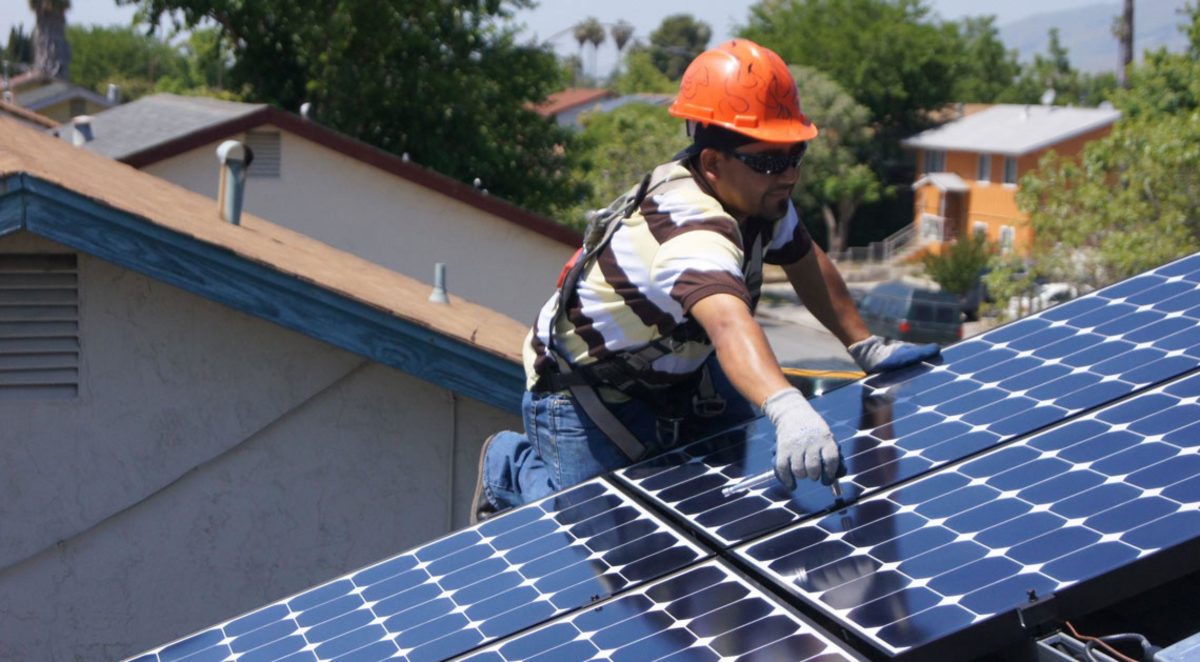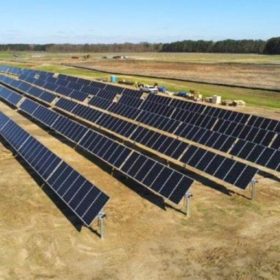Proposed changes to California’s net-metering program, the process by which the utility credits a customer’s bill for exporting excess solar production to the grid, is expected to harshly erode the value of rooftop residential solar without the aid of battery energy storage.
Payments to customers for their excess energy could be reduced by as much as 80%, reports the California Solar and Storage Association (CALSSA). Customers of PG&E, who normally would be paid about $0.224/kWh, would now be paid an estimated $0.049/kWh. Homeowners with solar attached to the grid could also face monthly charges as high as $75 a month. Bloomberg NEF estimates the change would extend battery-less solar system payback periods to 11 years, up from six to eight years.
Commercial customers would be charged “grid benefits charges”, monthly charges based on size of system. For example, in PG&E territory, a 750 kW system would pay $5,595 a month, and an agricultural systems sized at 500 kW would pay $4,805 a month.
Bloomberg NEF’s forecast for solar installations in the state would shrink if the currently-proposed rule passes, even if the federal solar tax credit is extended another ten years.
“We believe the solar-customer fixed fees averaging about $700 per year are in violation of the Public Utility Regulatory Policies Act of 1978 (“PURPA”). If adopted, the proposal will cost tens of thousands of jobs, especially among the thousands of solar companies unable to offer battery storage solutions due to supply shortages. The proposal is contrary both to what Californians have clearly said they want and to editorials in all major California newspapers. Finally, the proposed reduction to grandfathering for existing customers is an outrageous violation of trust and undermines the Commission’s stated interest in consumer protection.” Ed Fenster, co-executive chairman, Sunrun.
Batteries and grid flexibility
With these potential fees looming, Californians are preparing for the future and adopting battery energy storage. With a home battery, a customer does not need to rely on the net-metering to unlock the value of their solar system. There are several incentives in state for batteries, and having one helps customers avoid the monthly fixed charges in addition to avoiding value losses from net metering. But even so, on balance the payback period for residential solar is expected to be longer for NEM 3.0.
A battery does come with important benefits, like providing power in the case of a blackout. This offers increased resilience in an age of a changing climate and increased wildfires. A survey by SunPower of prospective solar customers in the U.S. indicated that about 40% of respondents said that they worry about outages on a monthly basis. One in five said that they were concerned about losing their power every week. One third of this group said they see high-profile outages, such as those in Texas this past February, as a central reason to shop for backup power sources. Of those considering solar, 70% said they plan to include a battery energy storage system.

However, batteries would not be used the way they should be to maximize energy efficiency, reduce carbon emissions, and unlock savings for California homeowners. Ed Fenster, co-executive chairman, Sunrun, said that California may mimic earlier stages of energy storage development in Hawaii, where homeowners would self-consume storage to avoid the monthly tariff, foregoing exporting to the grid and to their neighbors in demand-response programs.
Such power dispatch programs are studied to have benefits for grid reliability, lessening blackouts. They also use electricity more efficiently and lessen the need for energy storage capacity. A study by the University of Otago in New Zealand connected batteries over several neighborhoods, and aggregated them in a demand-response export system. The results found that the collective use of batteries had dramatic effects on both load smoothing and peak demand shaving. Aggregation of smart storage led to a reduction in per-house battery requirements by 50% for load-smoothing needs and by 90% or peak shaving. This method of electricity use represents a lower-carbon way to operate the grid.
The proposed NEM 3.0 could take effect as soon as January 27th, 2022, as the California Public Utilities Commission is set to vote.
This content is protected by copyright and may not be reused. If you want to cooperate with us and would like to reuse some of our content, please contact: editors@pv-magazine.com.









I wonder how much the power industry paid the PUC members for that little “favor”.
Whatever happened to “Watchdog” groups here in California?
Because I live in California and have seen this kind of upending of solar before, I built my system in 2010 totally “off-grid” and powered all the 120-volt lights and appliances from it with the utility being my back-up power and the 240-volt power supplier for the kitchen range and electric dryer. I cut my bill by 70% because I removed most of my tier-2 overages, but I also need to replace my 80 – 12-volt lead acid batteries every 6 years. it works out to $100.00 per month for batteries. You either pay the utility to be your battery or buy batteries. The only thing my “off-grid” system does that a grid supplied system is not use as much fossil fuel to heat and light my home. The utility is also asking the PUC for a 30% increase to build micro grids, just like I have with my off-grid system except for whole neighborhoods. So, ratepayers are paying for utility owned batteries rather than buying their own. In California, if you are not already in NEM-1 or NEM-2, your SOL.
Why is it the CPUC’s concern that homeowners add battery storage?
Grid scale energy storage with flow batteries, compressed air, flywheels, etc. makes far more sense. And private companies will make that investment on their own simply to make money time shifting power. It’s not that tough on a business.
Also small solar installers tend to not offer battery storage if they can even get the parts.
It just seems like something that was never a goal suddenly being sprung on us as a justification for taxing rooftop solar… rent seeking.
Nothing about this is justifiable.
Well, this is no surprise. Beleaguered PG&E is bearing the entire cost of climate change increases to transmission and rural distribution risk. Meanwhile, CCAs and behind-the-meter generation are reducing the kWh base over which are spread those costs, and the costs of undiminished peaking requirements. So it was impose a flat per-kW solar surcharge, or devise a household demand charge.
[BTW, the higher cost of rooftop solar in California makes the claimed 6-7 year payback improbable unless: 1) there is no consideration of the cost of money, or 2) the array was way oversized ten years ago to cash in on those favorable rates for excess generation.]
For folks with oversized systems, maybe these new grid-service charges make utility disconnection attractive (after getting the State battery incentives and collecting the federal tax credit for their batteries, of course.) 😁
I was thinking of going solar on the new year but screw the puc. The power company has had a inside person on the puc for years
Self generation and consumption should be the standard. Don’t expect me to buy an expensive battery system for everyone else to use. Degradation to batteries is not cheap so the less frequently they are used and the less deeply they are discharged the longer they will last. I’ve lived off grid with my own solar and batteries for 6 years and had the most resilient power in my area. Any kind of “grid” is going to be prone to failure and disaster.
This is a very interesting article but doesn’t explain how batteries should ideally be used vs how the author feels they will used with the new regulations. Aren’t all batteries connected to a PV system used for self consumption, so what is changing?
When you see a foolish bill trying to be passed you knows greens been passed under the table. Just saying.
How much is electricity worth in California during max solar generating hours?
I agree that residents should only get whatever the market value is (like duh).
However, I also know that it’s downright criminal for a utility to charge a monthly fee, extra, just for having solar panels. They already charge everyone a basic monthly charge for grid maintenance.
Gov’t getting involved is bad news for the future of solar/battery, except merely for using tax dollars to fund science research and manufacturing equipment development.
Besides, Tesla is making batteries cheaper. Hopefully, they will soon make solar cheaper, too.
Why not just configuring the inverters for zero export?
Its a lot cheapper than buying a battery!
You dont sell your surplus energy but if you choose your system size properly you can have a return on investment of 6-8 years.
A system you describe would only work during daylight hours and without a battery system would be intermittent every time a cloud passes between the sun and your panels. Batteries also modulate the voltage going into the pure sine wave inverters you would use to convert the 18-volt or 36-volt solar panels to 12-volt or 24- volt inverter needed inputs.
Who knows an aggressive Class Action Lawsuit firm. Clearly the PUC has pulled a Bait & Switch on all of us who invested in solar!!!
The hypocrisy of all the politicians who are allowing this to happen is deafening. Weren’t they the ones screaming about the existential threat of climate change and how we all MUST switch to renewable energy? And how there will be millions of Green New Jobs. Ha! I was about to add additional panels to my system. Not anymore, they would make me switch my entire system over to the NEM 3.0 with that addition. You would have to be stupid or bad at math to consider solar under this plan. Most Californians don’t live in their home long enough to just break even on the cost of the system alone.
Just the fact that they are going to end the NEM 2.0 agreement that we all bought into early than they promised is outrageous!
Class Action Lawsuit . . . I’m in!!!
Makes you wonder which politicians and state energy officials are heavily invested in battery manufacturers?
You can add more solar panels, just do not connect them to your existing on-grid system. Build a separate off-grid system with batteries and have that feed through a transfer switch to part of your home. The breakers in the transfer switch will power and protect the lights and appliance connected to those circuits including your level 1 EV charging station for your car. Any solar panel system that generates low voltage DC that charges batteries and does not connect to the grid does not need permits as long as it is under 50 volts. .(NEC article 720) The federal Tax Credit does not limit the size voltage or connection method and may be claimed for every all new solar or Solar with battery installations including inverters, charge controllers, conduit, wire and transfer switches as long as it is installed on your primary residence.
I guess there’s no good idea that big corporations can’t f-up. Can you say “GREED”.
I have made some serious personal/financial sacrifices this year to do my part to reduce my personal impact on the planet and PG&E, among others, wants to penalize the little guy.
We invested a lot of money to install the solar panels and even after the Federal tax Credit, we still have to pay off the loans we took out to pay for them. My monthly payment on a 5 year loan is $470.00 per month. Now add to this $64.00 per month PG&E service charge for an 8,000-watt system for as long as you are connected to the PG&E grid would add an additional cost $46,080.00 over 25 years almost double what I am paying for the panels themselves. All future solar panel systems would need to be installed and NOT connected to PG&E but rather to Batteries and a transfer switch to disconnect the utility for 7 months and only buy power during the late fall and winter months. from the utility or run a backup gasoline generator.
After their success in convincing the CPUC to penalize those who have already installed solar panels and to essentially kill off home solar, the utilities are almost surely now focused on how to stop clever people from finding new ways to use their panels to get a decent payback. I am doing the math right now to disconnect my solar from the grid and used my panels only to charge my cars.
Remember NEM-3 will only be for those who do not already have NEM-2 or Nem-1 and they will have NEM -3 after their contractual 20 years is up. By then, the jumbo utilities will be broken up into regional mini utilities or be bankrupted out of existence.
I have NEM 1.0 and just received the true-up bill. I had 600kwh surplus, but PGE only paid me approximately 0.040/kWh. FWIW, only 0.03/kWh 2 years ago.
Regarding to battery storage, one important factor to consider is the number of charging cycles.
This means that the storage will degrade over time. I live in Bay Area. My solar panels only generate at most 25% of the electricity used daily in winter time. This will mean that I will need 4x the numbers of panels to charge the battery pack for one day use in winter, but then there will be too much excessive generation in summer. This implies that the battery pack will have to be big enough to store the energy at peak season as well.
I might be look at this wrongly, but from the above analysis, the solar system with battery pack is going to be very costly even after the tax credit. For anyone lives in the East Bay, it is a better deal to switch to the East Bay community power provider which is a better deal than NEM 3.0 solar installation, IMHO.
I feel the same as James – PUC is very much in bed with PGE and never pro-consummers. They screw us just as much as PGE!!
NEW 3.0 as proposed is a big disappointment for those of us who “bit” when the state asked us to invest. I feel betrayed.
However…..maybe this is the time to reset how we do solar in California. An optimum solution would be to continue to allow home solar investments, but avoid putting panels on every roof. Panels belong in the desert. Batteries belong at the home, condo or even apartment. This is a FAKE sell sheet to explain:
https://uploads.disquscdn.com/images/6039da4a8aa3f5585fe4922ef0307efcedbf6ca64620de972ebe24d0e95b6ffd.jpg
And a diagram to explain:
https://uploads.disquscdn.com/images/4e3a3216ecf36f7f8210151712d3809a371b7502ccf09a3d3b9ce10838220884.jpg
Not as dire a situation as one would think. One recent installs I have been able to provide inverter technology that can supply power to the home during the day with or without battery backup. These inverters can be installed as a retrofit, replacing the grid tie units. The only purpose for the grid is then to act as a pass through during low production periods and the batteries, if installed, are low or to charge batteries when they reach a specified low voltage level. It places PGE in a backup position and makes them closer to what they should be, irrelevant in residential applications.
Enphase Energy starts shipping IQ8 microinverters in North America
by Anne Fischer
The Enphase IQ8 has started production shipments in North America. The IQ8 claim to fame is that it is capable of forming a microgrid during a power outage, providing backup power even without a battery. How does that happen? The IQ8 can limit energy capture to just what the home is consuming, so in the event that the grid suffers a power failure, a proprietary, intelligent chip within the IQ8 will seamlessly switch between on or off grid.
Read “Enphase going Einstein with IQ8 solar power inverters”.
Just in time for NEM-3 in California…
Yes Enphase is good if you already have micro inverters. But there are a number of other manufacturers that have tapped the micro grid market and have been producing them for several years now. The Outback Skybox is one example, while not heavily advertised it is an excellent grid tie or stand alone unit that works with or without a battery. Sol-Ark is another. Growatt is the second largest inverter manufacturer in the world and have taken the challenge seriously. There are many more already on the market and if one chooses, based on whether or not they own their own equipment, they can change out the inverter side of their system quite easily and inexpensively.
Electric energy cost is and has been very confusing! PG&E allows the download of your past electric consumption in KWH per every hour for years, with the $ charge. But with TOU rates, changing by hour and season, and power to and from the grid at different rates, it is super difficult to do ‘what-if’ planning based on past information, and anticipated solar production, and different ways to use / export / store the solar energy. PG&E needs to add the necessary rate computations to their download data as a minimum.
There are various costs to consider. For the customer, for the utility, and for society the monetary issue, and the CO2 reduction issue both should be considered. Climate Change cost $160 billion in damage in 2021 in the US, and it is going up. It currently costs 50 cents per pound ($10/gallon of gas) to pull CO2 out of the atmosphere.
The PUC should be trying to reduce the cost of increasing electrical demand, including the expense of the CO2 emissions. I don’t think they are doing that. It looks like they are just trying to help the utilities make money, at the expense of everyone, and especially for those who are trying to reduce emissions.
Unfortunately, I am just in the process to put solar panels on my roof. I started to get bids for it early fall of las year, but given the shortage of everything due to Covid, the company will start to put the panels on my roof in about 2 to 3 weeks…. meaning after January 27th….. I actually opted for a larger system because I will also throw out my gas furnace and replace it with a heat pump. And at one point I thought of getting an EV. So I thought it was a good idea to plan ahead. What a total fool I was. Now I am being asked to pay about $80 per month (my current electricity bill itself is around $40) + the cost for the electricity I will need at night from the grid. it makes me feel like a complete fool. Our dear friends at PG&E and their buddies at the CPUC must be laughing their heads off. If I could (but I do have a contract already signed with the solar company) I would immediately cancel putting the panels on my roof. I did a lot of calculations and even so it is expensive, under NEM2.0, I thought it is the right thing to do to reduce our CO2 foot print. After NEM 3.0 will be in place on January 27th, it will be a complete loss for me. I also do not like to install batteries in the garage (so I could charge an EV in the future) but until they have a longer lifespan, I really don’t think I am ready to invest another ~$12k into batteries that have a lifespan of around 10 years. So just for the solar panel tax and the battery cost per year I will have to calculate around $2100 a year…… and that doesn’t even include paying for the actual electricity that I will be using over the year because you get almost nothing from PG&E back for the power you move into the grid. If I would just have stayed with our old gas furnace and electricity, I would have paid a lot less compared to what I have to pay now. The idea of a “Solar panel” tax is so outrages it’s difficult to believe what kind of a sick mind could have thought of putting a tax on a system that reduces CO2 emission and relies on a substantial personal investment. California is driven by greed as any of the other 49 states. Shame on PG&E, shame on the CPUC and shame on political leadership in Sacramento. It’s infuriating !
Just cancel your solar panel installation as written because they sold it to you based on NEM-2.0 and if you cannot get NEM-2.0 then the deal if off. Since the NEM-3.0 does not go into effect until late May, they could get the job done by the end of February and connected in April getting you grandfathered in to NEM-2.0. if they delay the installation any longer, just tell them they have broken the contract by not installing the system in a timely manner. Stay on top of the project and if it looks like you may need to go off-grid with your system, make sure you have an approved transfer switch that feeds your home rather than the grid. The $8.00 per month for grid connection fees per kilo watt is just too much money for anyone to spend. The payback of 4 cents per kilowatt hour would only give you $4.00 credit for every $8.00 you pay in fees after spending all that money getting your new system. Going off=grid would be no fees and you would just keep all you produce You will need batteries but don’t go into lithium batteries when lead acid battery systems are available at one fourth of the price. Deep Cycle lead acid batteries last 6 years and replacing them 3 times would be 24 years of service for just 10 years of lithium for the same price. lead acid will not catch fire and can be user replicable if you keep the system low voltage 12 Volt, 24 volt or 48 volts. The pure sine wave inverters will up convert to usable AC power and your solar panel system with MPPT charge controllers will just charge your batteries at lower voltages also. My 80 deep cycle marine/RV batteries are equivalent to 4 Tesla power walls on my off-grid home and the cost to replace them all is $6,400.00 and to replace 4 power walls is $30,000.00.